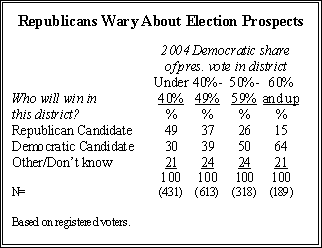by Andrew Kohut
In an election environment which seems to favor the Democrats in so many ways, the Republicans continue to hold two strong cards; they have more money and they are better at getting out the vote than are the Democrats. In a recent interview NPR’s Robert Siegel asked Karl Rove (All Things Considered, October 24, 2006) whether he intended to mostly spend his war chest on TV advertising. Rove, the architect of Bush’s two presidential election victories explained that a lot of money will be spent on the ground war:
<blockquote >
SIEGEL: And all of that money, I assume, would put a lot of television advertising out there
ROVE: Well, on a lot ground and a lot of organized volunteer activity. You need to have, you know, you need to have the staff and the infrastructure and the materials to give to your last, to your large army of volunteers to get out the vote.
And Rove is no doubt aware that he doesn’t have to launch a national ground war. The handicappers say that only about 50 seats of the 435 seats are competitive. But, polling by the Pew Research Center raises some questions about how much ground the Republicans have to protect and clearly illustrates the challenge the party faces in mobilizing its base.
First, the size of the challenge may be bigger than presumed. Pew’s mid-October, nationwide survey over-sampled voters living in Congressional districts thought to be competitive by a consensus of the handicappers. It found that with less than two weeks to go before the midterm election, the Democrats not only continued to maintain a double-digit advantage nationally, but also held virtually the same lead in the competitive districts that will almost certainly determine which party controls the House of Representatives.
In addition, Pew polling finds that Democrats are more enthusiastic about voting this year, while Republicans are more wary about their party’s election prospects.

Read the full article in Times Select (subscription required)


